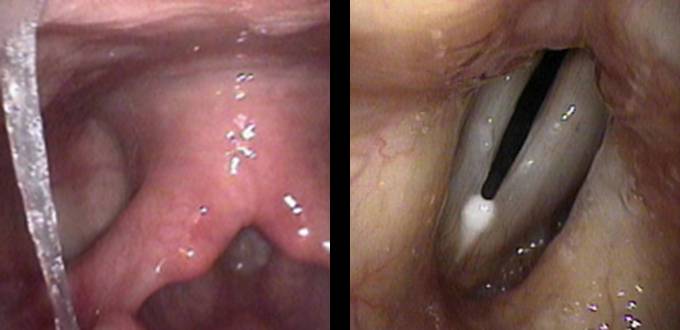At-A-Glance
- The lining membranes of the respiratory tract ar emucus membranes, and that lining continuously produces a protective mucus layer. Under normal conditions, the nose and throat produce a quart of it every day, and this normal mucus is swallowed unnoticed.
- By far, the most common cause of post-nasal drip, thick mucus dripping down the back of the throat, is acid reflux, specifically Respiratory Reflux (aka LPR). Indeed, too-much thick mucus and chronic throat clearing are the most common symptoms of LPR.
- Post-nasal drip is often attributed to allergies; however, the excess mucus with allergy is thin, clear, and rarely bothers the lower throat or voice. On the other hand, the mucus of reflux-caused post-nasal drip is thick and hard to move, especially when it lands on the vocal cords.
- Post-nasal drip is sometimes blamed for causing chronic cough; one doesn’t cause the other; however, post-nasal drip and chronic cough are both symptoms of reflux. Indeed, LPR often causes many symptoms, including chronic throat clearing, ear, nose and sinus symptoms, sore throat, hoarseness, lump-in-the-throat sensation, difficulty swallowing, and shortness of breath
- The type of reflux that causes post-nasal drip is usually Silent Reflux because only 17% of people with LPR reflux have heartburn or indigestion. Silent reflux usually occurs at night while you are asleep.
- As treatment for post-nasal drip, physicians often mistakenly prescribe nose drops, saline sprays, steroid inhalers, sinus washers, and antihistamines … none of which work. Obviously, after the correct LPR diagnosis is made, treatment must be directed at reflux control.
What Is Mucus and What Does it Do?
Mucus is a slippery secretion produced by the mucous membranes that line the respiratory and digestive tracts. Mucus is a gel-like, colloidal suspension produced by goblet cells imbedded in the mucus membranes. Mucus contains mucins, antimicrobial enzymes, immunoglobulins (mostly IgA), and glycoproteins.
Mucus forms a surface barrier to help protect the lining of the respiratory tract by preventing penetration by bacteria, fungi, and viruses. The mucus blanket also protects the lungs by trapping foreign particles, particularly in the nose during normal respiration.
Mucus has a second function; it acts as a lubricant to ease palatal movement and swallowing. Under normal circumstances, the nose and throat produce about a quart of mucus a day, which is usually swallowed unnoticed.
What Causes Post-Nasal Drip?
If you look on the Internet, post-nasal drip may be caused by colds, changing weather, bright lights, certain medicines, pregnancy, spicy foods, chemical fumes, deviated septums, allergies, sinus infections, and acid reflux … with reflux usually being mentioned last in passing or not at all in most articles.
Colds do not cause chronic post-nasal drip; however, any respiratory infection can trigger or worsen acid reflux, especially in people with chronic cough. Thus, post-viral post-nasal drip is inevitably reflux-caused. Changing weather, particularly cold weather, can cause almost-immediate nasal congestion and runny nose, but not chronic post-nasal drip. As far as bright lights and spicy foods are concerned, the former is complete nonsense, and the latter, spicy foods, may trigger reflux.
Pregnancy is associated with hormonal nasal congestion, but the post-nasal drip of pregnancy is reflux, common in pregnancy. Chemical fumes, if chronic, can cause persistent nose and throat symptoms, but brief exposures not so much. In the case of fumes, the person would be aware of the onset of symptoms with exposure. In a word, this cause of post-nasal drip is uncommon. Deviated septums do not cause post-nasal drip, period … beware of the eager surgeon!
What’s left? Allergies, sinus infections, and acid reflux, all potentially causes of chronic post-nasal drip. When the mucus membranes are irritated or inflamed by any cause, they produce more, excess mucus; however, the quantity and quality of the mucus is not the same for allergy, sinusitis, and reflux. How are these three differentiated?
Allergic Mucus Is Copious and Thin. When people have inhalant allergies, e.g., dust, mold, pollen, the consistency of the mucus produced is usually copious, clear, thin, and watery. Runny nose is common, and many people with allergic rhinitis walk around carrying tissue, especially when exposed to their inciting allergens. In addition, most people with allergies have related symptoms such as stuffy nose, sneezing, and watery, red, swollen, or itchy eyes. Chronic throat-clearing is not usually a symptom of allergy.
When patients with allergic rhinitis are examined by a knowledgeable physician, the usual nasal findings are boggy, swollen, purplish mucosa with a thin, clear-as-glass type of mucus. People with allergic rhinitis can be successfully treated with anti-histamines, sinus washes, and/or steroid inhalers.
Reflux Mucus Is Sparse, Thick, and Associated with Other Reflux Symptoms. With 75,000 people responding to an on-line poll, Think you might have reflux? Which symptom(s) do you have? — Post-nasal drip was the number one symptom, followed by chronic-throat clearing. Heartburn was way down the list at #8, after all of the other symptoms of LPR.
The consistency of reflux-caused mucus is much thicker than that of allergy, and for the sufferer, reflux mucus is hard to move, especially when it gets on the vocal cords. I think the word associated with this is “hocking.” On examination, reflux mucus is thick, white, and often on the vocal cords.
Sinusitis Mucus Is Salty, Sour, and Sometimes Green. In most cases of sinusitis, there is no post-nasal drip because the affected sinuses are completely blocked; no sinus drainage is the problem. But when sinusitis is breaking up, the sinus opening (ostia) open to disgorge their purulent contents, but this usually happens over the course of a day or so and is not usually a chronic problem. The taste may be fetid.
The Diagnoses of Allergy and Reflux Are Often Confused
The Big Two Are #1 Reflux and #2 Allergy. Despite misleading information on the Internet, not all post-nasal drip is allergy, but most self-diagnosing, self-treating people falsely assume that their post-nasal drip is allergy … when in fact, they have Silent Reflux. Indeed, reflux is by far the most common cause of symptomatic, sticky post-nasal drip.
With reflux, patients can have nasal congestion and runny nose, too, but not usually, sneezing or itchy eyes. The most common “other” symptoms associated with reflux are chronic throat-clearing, a sensation of a lump in the throat, hoarseness, and cough. Many physicians are unaware of the clinical differences between allergy and reflux; and specifically, they are unaware of the different physical findings. And by the way, a lot of people have both allergies and reflux … and yes, allergies can make reflux worse.

The left photo shows a band of allergic mucus in the mid-throat; it is clear, thin, and easily swallowed. On the right, white reflux mucus is seen between the vocal cords; it is sticky, thick, and hard to cough out. (BTW: Photos taken using different light: left normal and right strobe.)
Post-Nasal Drip Is Just a Symptom, Not a Diagnosis
Post-nasal drip is just a symptom, and it does not cause other conditions or diseases such as sinus disease, sore throat, or chronic cough. Chronic cough is never due to allergy or to post-nasal drip; but it is often due to respiratory reflux.
Increased mucus and/or post-nasal drip can be confused with another reflux-caused condition called water brash, which is excessive salivation that occurs in response (vagus nerve reflex) to acid reflux.
Respiratory Reflux Causes Most Sinus Problems … Avoid the Surgeon!
The nasal sinuses (maxillary, ethmoid, sphenoid and frontal) are hollow cavities in the face (the cheek areas, around and above the eyes); and what they all have in common is that they have ostia (openings) that allow them to breathe and drain into the nose.
Facial pressure and post-nasal drip can be caused by sinus irritation by reflux; however, it is not true sinusitis. On sinus X-rays and CT-scans, to make the diagnosis of sinusitis, the affected sinuses must be completely opacified, that is, full of fluid with no air present. When there is an air-fluid level and/or mucoperiosteal thickening, AVOID SURGERY. Indeed, some radiologists call those findings “chronic sinusitis,” perhaps in deference to surgeons who take this to mean surgery is needed. But, it isn’t … it’s probably reflux!
The angriest patients of my patients have had multiple, unsuccessful, sinus surgeries. Apparently neither the patient nor the doctor knew that the underlying problem was reflux. They come to me with sinus pressure and annoying post-nasal drip and ask me to diagnose and treat their reflux.
In conclusion, LPR reflux is by far the most common cause of troublesome post-nasal drip; it can be differentiated from allergy, and it can be effectively treated.










